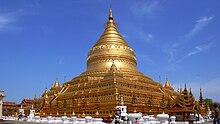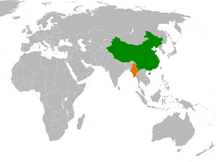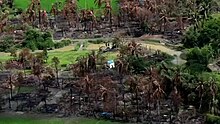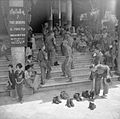Portal:Myanmar

Myanmar, officially the Republic of the Union of Myanmar and also known as Burma (the official name until 1989), is a country in Southeast Asia. It is the largest country by area in Mainland Southeast Asia and has a population of about 55 million. It is bordered by Bangladesh and India to its northwest, China to its northeast, Laos and Thailand to its east and southeast, and the Andaman Sea and the Bay of Bengal to its south and southwest. The country's capital city is Naypyidaw, and its largest city is Yangon (formerly Rangoon).
Myanmar is a member of the East Asia Summit, Non-Aligned Movement, ASEAN, and BIMSTEC, but it is not a member of the Commonwealth of Nations despite once being part of the British Empire. Myanmar is a Dialogue Partner of the Shanghai Cooperation Organization. The country is very rich in natural resources, such as jade, gems, oil, natural gas, teak and other minerals, as well as also endowed with renewable energy, having the highest solar power potential compared to other countries of the Great Mekong Subregion. However, Myanmar has long suffered from instability, factional violence, corruption, poor infrastructure, as well as a long history of colonial exploitation with little regard to human development. In 2013, its GDP (nominal) stood at US$56.7 billion and its GDP (PPP) at US$221.5 billion. The income gap in Myanmar is among the widest in the world, as a large proportion of the economy is controlled by cronies of the military junta. Myanmar is one of the least developed countries; as of 2020, according to the Human Development Index, it ranks 147 out of 189 countries in terms of human development, the lowest in Southeast Asia. Since 2021, more than 600,000 people were displaced across Myanmar due to the surge in violence post-coup, with more than 3 million people in dire need of humanitarian assistance. (Full article...)
Selected articles -
-

U Thaw (Burmese: ဦးသော်; 5 September 1893 – 25 June 1980), known honorifically as Baganset U Thaw (Burmese: ပန်းကန်စက် ဦးသော်), was a Burmese businessman, trader, administrator, and politician. He was the first manufacturer of porcelain products in Burma. He was a member of the Legislative Council of Burma, patron of the Young Men's Buddhist Association (YMBA), chairman of Myoma National High School Administration Board, and one of the leaders of the General Council of Burmese Associations. (Full article...) -
The Rohingya genocide is a series of ongoing persecutions and killings of the Muslim Rohingya people by the military of Myanmar. The genocide has consisted of two phases to date: the first was a military crackdown that occurred from October 2016 to January 2017, and the second has been occurring since August 2017. The crisis forced over a million Rohingya to flee to other countries. Most fled to Bangladesh, resulting in the creation of the world's largest refugee camp, while others escaped to India, Thailand, Malaysia, and other parts of South and Southeast Asia, where they continue to face persecution. Many other countries consider these events ethnic cleansing.
The persecution of Rohingya Muslims in Myanmar dates back to at least the 1970s. Since then, the Rohingya people have been persecuted on a regular basis by the government and Buddhist nationalists. In late 2016, Myanmar's armed forces and police launched a major crackdown against the people in Rakhine State which is located in the country's northwestern region. The Burmese military was accused of committing ethnic cleansing and genocide by various United Nations agencies, International Criminal Court officials, human rights groups, journalists, and governments. The UN found evidence of wide-scale human rights violations, including extrajudicial killings; summary executions; gang rapes; arson of Rohingya villages, businesses, and schools; and infanticides. At least 6,700 Rohingya were killed in the first month of attacks, between 25 August and September 24, 2017. The Burmese government dismissed these findings by stating they are "exaggerations". Using statistical extrapolations which were based on surveys which were conducted with a total of 3,321 Rohingya refugee households in Cox's Bazar, Bangladesh, a study which was conducted in January 2018 estimated that the military and the local Rakhine population killed at least 25,000 Rohingya people and perpetrated gang rapes and other forms of sexual violence against 18,000 Rohingya women and girls. They estimated that 116,000 Rohingya were beaten, and 36,000 were thrown into fires. (Full article...) -

Effect of the 2004 Indian Ocean earthquake on Myanmar
Official reports from the government of Myanmar (Burma) cite a death toll of 90 due to the tsunami caused by the 2004 Indian Ocean earthquake on 26 December 2004. However, some estimates put the toll at between 400 and 600. 30,000 citizens of Burma were estimated to be in need of shelter, food and water, and 788 buildings were reported damaged and destroyed.
An NGO estimated that 2,500 citizens of Burma based in Phang Nga Province, Thailand during the event may have been killed, and that 7,000 Burmese were still unaccounted for. Many of these missing were, however, not presumed to be dead. Many refugees fled to Thailand's interior after the destruction, or were deported or chased back into the hills that divide the countries by Thai authorities. (Full article...) -

The Shwezigon Pagoda or Shwezigon Paya (ရွှေစည်းခုံဘုရား [ɕwèzíɡòʊɰ̃ pʰəjá]) is a Buddhist stupa located in Nyaung-U, Myanmar. A prototype of Burmese stupas, it consists of a circular gold leaf-gilded stupa surrounded by smaller temples and shrines. Construction of the Shwezigon Pagoda began during the reign of King Anawrahta (r. 1044–1077), the founder of the Pagan Empire, in 1059–1060 and was completed in 1102, during the reign of his son King Kyansittha. Over the centuries the pagoda had been damaged by many earthquakes and other natural calamities, and has been refurbished several times. In recent renovations it has been covered by more than 30,000 copper plates. However, the lowest level terraces have remained as they were.
This pagoda, a sacred Buddhist religious place, is believed to enshrine a bone and tooth of Gautama Buddha. The pagoda is in the form of a cone formed by five square terraces with a central solid core. There are footprints below the four standing Buddha statues here. Jataka legends are depicted on glazed terra-cotta tiles set into three rectangular terraces. At the entrance of the pagoda there are large statues of guardians of the temple. There are also four bronze standing statues of Buddha which are stated to be of the current age Buddha. At the outer limits of the pagoda there are 37 nats deified along with an intricately carved wooden sculpture of Thagyamin, the Burmese version of the Indian god Indra. Within the compound of the Shwezigon Pagoda there is a stone pillar containing Mon language inscriptions dedicated by Kyansittha. (Full article...) -
Lake of No Return (Naung Yang in Tai languages) is a body of water in Myanmar, lying in the area of the Pangsau Pass (3727') on the India–Myanmar border south of Pangsau (also called Pansaung) village. The lake is 1.4 km in length and 0.8 km in width at its widest part. It is located 2.5 km to the southwest of the Ledo Road, formerly called Stilwell Road, the road the Western Allies started building in 1942 to supply the Chinese armies of Chiang Kai-shek.
The area is home to the Tangsa community. Since the improvement of relations between India and Myanmar , the lake has come to play a part in the development of tourism in the nearby Indian Changlang District, which borders on Myanmar. (Full article...) -

Rice plantation in Myanmar, 2006
Rice production in Myanmar accounts for approximately 43% of total agricultural production in the country, making it the seventh largest producer of rice in the world. Out of 67.6 million hectares of land, 12.8 million are used for cultivation. In 2019 alone, Myanmar accounted for 13,300 million metric tons of milled rice production.
Throughout history, Myanmar established itself as a major rice producing and exporting country due to favourable weather for rice paddies and governmental intervention in the form of agricultural policies. The production is undertaken using traditional cultivation methods, particularly during monsoon season, which has led to the development of different varieties of rice. Recent global economic policies have led to increasing international cooperation with NGOs and other organisations, that have provided financial and technological assistance to rice farmers. (Full article...) -

Myanmar (Burma) and North Korea established bilateral diplomatic relations in May 1975. The history of contacts between the two countries goes back to 1948, the year of the declaration of Burmese independence. Initially, however, Burma under U Nu favored Syngman Rhee's government in the south of Korea. During and after the Korean War, Burma balanced the interest of North and South Korea, taking into consideration the position of China. After the 1975 establishment of diplomatic relations Burma began to shift toward North Korea, which was also nominally socialist and equally wary of Western imperialism.
The Rangoon bombing on 9 October 1983 was a turning point in Myanmar–North Korea relations. Once it found out that North Koreans were behind the attack, Myanmar cut off diplomatic relations and went as far as withdrawing formal recognition of the country. Relations began to recover during the years of the Sunshine Policy when South Korea encouraged the North's rapprochement with Myanmar. Strategic considerations brought Myanmar and North Korea even closer. Myanmar had natural resources that North Korea needed, and North Korea began supplying Myanmar with military technology. Diplomatic relations were restored on 25 April 2007. (Full article...) -
In the Burmese language, the term mont (Burmese: မုန့်; pronounced [mo̰ʊɴ]) translates to "snack", and refers to a wide variety of prepared foods, ranging from sweet desserts to savory food items that may be cooked by steaming, baking, frying, deep-frying, or boiling. Foods made from wheat or rice flour are generally called mont, but the term may also refer to certain varieties of noodle dishes, such as mohinga. Burmese mont are typically eaten with tea during breakfast or afternoon tea time.
Each variety of mont is designated by a descriptive word or phrase that precedes or follows the word mont, such as htoe mont (lit. 'snack that is prodded') or mont lone yay baw (lit. 'floating snack balls'). The term mont has been borrowed into several regional languages, including into Shan as မုၼ်း and into Jingpho as muk. (Full article...) -
The People's Defence Force is the armed wing of the National Unity Government in Myanmar. The armed wing was formed by the NUG from youths and pro-democracy activists on 5 May 2021 in response to the coup d'état that occurred on 1 February 2021 that put the military junta and their armed wing the Tatmadaw in power. The military junta designated it as a terrorist organisation on 8 May 2021. In October 2021, NUG's Ministry of Defence announced that it had formed a central committee to coordinate military operations across the country.
According to the NUG statement, the PDF is divided into five regional commands (Northern, Southern, Central, Eastern and Western commands), each mounting at least three brigades. Each brigade consists of five battalions, which divide into four companies. On 13 July 2021, NUG's minister of defence Yee Mon stated that the strength of the newly-formed militia was expected to reach 8,000 by the end of the month. Estimates by The Irrawaddy put the PDF's numbers at 65,000 in November 2022. More recent estimates put the PDF's strength at 100,000, even though not all are believed to be fully armed and trained. The PDF's leadership believe in the usage of guerrilla warfare tactics to achieve their aims. (Full article...) -

China–Myanmar relations (Chinese: 中缅关系; Burmese: တရုတ်မြန်မာဆက်ဆံရေး) are the international relations between the People's Republic of China and Myanmar. China and Myanmar have active bilateral relations with each other. The relation is often described as a pauk-phaw relationship (Burmese: ပေါက်ဖော်), based a Burmese term for kinsfolk that implicates special asymmetric obligations between the two countries.
Bilateral relations between China and Myanmar have faced difficulties due to the effects of alleged Chinese-sponsored debt-traps and alleged Chinese backing of rebels in Myanmar's territories. In recent years, the relations between China and Myanmar have faced some problems due to ongoing clashes between ethnic Chinese rebels and the Myanmar military near the China–Myanmar border. (Full article...)
Did you know (auto-generated) -

- ... that the Burmese and South Korean first ladies held their first informal conversation 44 years after the establishment of bilateral relations between the two countries?
- ... that Rolling Stone named Mission of Burma's "Academy Fight Song" as one of the 100 greatest debut singles of all time?
- ... that while defending Zaw Myint Maung following his arrest by the Myanmar junta, lawyer Ywet Nu Aung was herself arrested and charged?
- ... that the Myanmar Coast Guard was initially proposed as a civilian law enforcement agency before being established as a branch of the military three years later?
- ... that the Burmese Buddhist monk Sagyo Thu-Myat successfully lobbied for the recalibration of the Burmese calendar?
- ... that Molly Burman resumed releasing music three years later after finding that "Happy Things" had accrued a million streams on Spotify?
- ... that the mission of the United Nations special envoy on Myanmar has been called a "diplomatic graveyard"?
- ... that clashes between the Myanmar military and local armed groups broke out in Lay Kay Kaw six years after it was established as a "town of peace" between the parties?
Related portals and projects
General images -
-
Mountains near Pindaya on the Shan Plateau (from Geography of Myanmar)
-
The restored Taungoo or Nyaungyan dynasty c. 1650 CE. (from History of Myanmar)
-
Hlei pyaingbwè - a Burmese regatta (from Culture of Myanmar)
-
Myinhkin thabin - equestrian sport (from Culture of Myanmar)
-
Protesters in Yangon carrying signs reading "Free Daw Aung San Suu Kyi" on 8 February 2021. (from History of Myanmar)
-
Mount Popa, a dormant volcano in the Central Lowlands (from Geography of Myanmar)
-
Saint Mary's Cathedral in Downtown Yangon is the largest Roman Catholic cathedral in Burma. (from Culture of Myanmar)
-
Aerial view of a burned Rohingya village in Rakhine state, Myanmar, September 2017 (from History of Myanmar)
-
Boxing match, 19th-century watercolour (from Culture of Myanmar)
-
Political Map of Burma (Myanmar) c. 1450 CE. (from History of Myanmar)
-
British soldiers on patrol in the ruins of the Burmese town of Bahe during the advance on Mandalay, January 1945. (from History of Myanmar)
-
Jade Mine in Hpakant (from Geography of Myanmar)
-
Portuguese ruler and soldiers mounting an Elephant. Philips, Jan Caspar (draughtsman and engraver) (from History of Myanmar)
-
Protesters in Yangon with a banner that reads non-violence: national movement in Burmese, in the background is Shwedagon Pagoda. (from History of Myanmar)
-
Aung San Suu Kyi addresses crowds at the NLD headquarters shortly after her release. (from History of Myanmar)
-
Two female musicians play the saung at a performance in Mandalay. (from Culture of Myanmar)
-
Vegetable stall on the roadside at the Madras Lancer Lines, Mandalay, January 1886. Photographer: Hooper, Willoughby Wallace (1837–1912). (from History of Myanmar)
-
A wedding procession, with the groom and bride dressed in traditional Burmese wedding clothes, reminiscent of royal attire (from Culture of Myanmar)
-
A large fracture on the Mingun Pahtodawgyi caused by the 1839 Ava earthquake. (from Geography of Myanmar)
-
Recorder's Court on Sule Pagoda Road, with the Sule Pagoda at the far end, Rangoon, 1868. Photographer: J. Jackson. (from History of Myanmar)
-
Grandfather Island, Dawei (from Geography of Myanmar)
-
Myanmar (Burma) map of Köppen climate classification (from Geography of Myanmar)
-
The paddle steamer Ramapoora (right) of the British India Steam Navigation Company on the Rangoon river having just arrived from Moulmein. 1895. Photographers: Watts and Skeen (from History of Myanmar)
-
A wide range of Burmese lacquerware from Bagan (from Culture of Myanmar)
-
British soldiers dismantling cannons belonging to King Thibaw's forces, Third Anglo-Burmese War, Ava, 27 November 1885. Photographer: Hooper, Willoughby Wallace (1837–1912). (from History of Myanmar)
-
The shores of Irrawaddy River at Nyaung-U, Bagan (from Geography of Myanmar)
-
A group of Buddhist worshipers at Shwedagon Pagoda, an important religious site for Burmese Buddhists (from Culture of Myanmar)
-
Temples at Mrauk U, was the capital of the Mrauk U Kingdom, which ruled over what is now Rakhine State. (from History of Myanmar)
-
Salween river at Mae Sam Laep on the Thai-Myanmar border (from Geography of Myanmar)
-
British soldiers remove their shoes at the entrance of Shwedagon Pagoda. To the left, a sign reads "Foot wearing is strictly prohibited" in Burmese, English, Tamil, and Urdu. (from Culture of Myanmar)
-
19th-century funeral cart and spire, which would form part of the procession from the home to the place of cremation (from Culture of Myanmar)
-
Former US President Barack Obama poses barefoot on the grounds of Shwedagon Pagoda, one of Myanmar's major Buddhist pilgrimage sites. (from Culture of Myanmar)
-
A bull fight, 19th-century watercolour (from Culture of Myanmar)
-
Sculpture of Myanmar mythical lion (from Culture of Myanmar)
-
Pagan Kingdom during Narapatisithu's reign. Burmese chronicles also claim Kengtung and Chiang Mai. Core areas shown in darker yellow. Peripheral areas in light yellow. Pagan incorporated key ports of Lower Burma into its core administration by the 13th century. (from History of Myanmar)
-
A theatrical performance of the Mon dance (from Culture of Myanmar)
Major topics
Categories
More topics
Associated WikimediaThe following Wikimedia Foundation sister projects provide more on this subject:
More portals |







































































